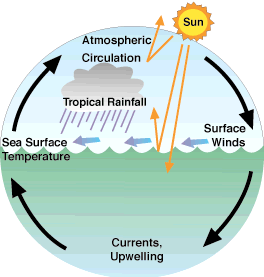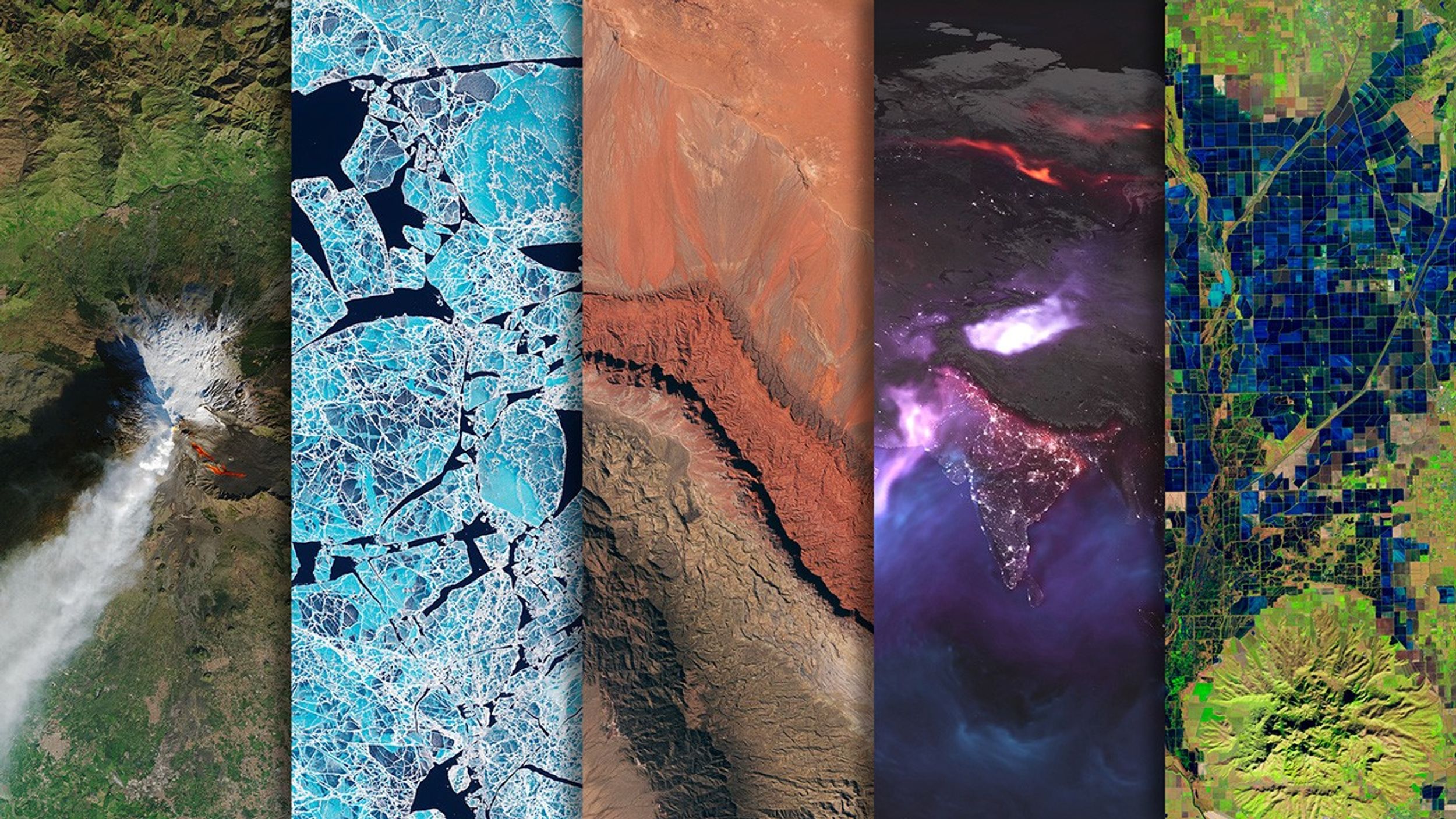There is clear evidence that Earth's surface temperature has risen by about 0.5°C over the last 100 years. However, there is some uncertainty as to the causes of this temperature increase, as well as what its short- and long-term effects will be on regional and global scales. Predictive computer models indicate that given a steady rise in levels of greenhouse gases, such as carbon dioxide, there will be a corresponding increase in surface temperatures. Yet surprisingly, despite a 30 percent increase in carbon dioxide levels since the beginning of the Industrial Revolution, temperatures haven't risen as much as the models predicted. Why? Because greenhouse gases aren't the only influence on temperature. There are many other variables--such clouds, aerosols, and the ocean--that also affect temperature.
Air and sea embrace
The Earth's ocean and atmosphere are locked in such an intricate embrace--as one changes so changes the other. At the interface between air and sea, there is a constant flow of information, as vast amounts of energy and chemicals (in the form of gases and aerosols) are continually being exchanged. If energy and chemicals are the languages that program the behavior of atmosphere and ocean, then regional and global scale climate variations are the outputs from this complex system. If scientists could learn to better interpret the "dialogue" between ocean and atmosphere, they could do a better job of predicting regional and global climate change.
Since the 1960s, scientists have developed sophisticated computer models to help them understand the ocean's role in moderating climate. Yet many questions remain unanswered. In recent decades, the ocean has partially offset the anticipated global warming due to rising greenhouse gas levels by exerting a cooling effect on climate. But, over the long run, scientists don't know whether the ocean's cooling influence will persist. Some theorize that if the ocean's circulation system changes, then the ocean could contribute to, or even amplify, global warming. At the heart of global-scale oceanography are the following questions: How will global warming affect life in the ocean? How do ocean temperature, chemistry, and biology influence climate? Are human activities contributing to changes in the marine environment and, in turn, how might these changes feed back to affect us?
Space-based oceanography

Reliable sea surface temperature measurements from space-based sensors have been a goal of oceanographers since the late 1960s. For the first time ever, NASA's Earth Observing System (EOS) missions will provide oceanographers with the radiometric resolution and precision, the scientific calibration, the surface viewing geometry, and the ability to remove atmospheric effects (such as clouds and aerosols) that will enable measurements of sea surface temperature accurate to within 0.5 Kelvin. These data will enable a better understanding of physical ocean-atmosphere coupling--particularly during El Niño events.
Moreover, by precisely measuring ocean color, scientists can accurately estimate the concentrations of phytoplankton on a global scale. Coupling ocean color measurements with atmospheric aerosol and trace gas measurements will also yield new insights into the chemical links between ocean and atmosphere.
Physical coupling with the atmosphere

The ocean couples with the atmosphere in two main ways. The first way is physically, through the exchange of heat, water, and momentum. Covering more than 70 percent of the Earth's surface and containing about 97 percent of its surface water, the ocean stores vast amounts of energy in the form of heat. The ocean receives most of its heat along the equator, where incoming solar radiation is about double that received at the poles. Hence, sea surfaces are much warmer along the equator than at the poles.
Ocean and atmosphere move because they are fluid. The speed and direction of air and sea currents are determined primarily by air temperature gradients. As heat rises and eventually escapes the ocean to warm the overlying atmosphere, it creates air temperature gradients and, consequently, winds. In turn, winds push against the sea surface and drive ocean current patterns. Over time, a complex system of currents was established whereby the ocean transports a tremendous amount of heat toward the poles. Because heat escapes more readily into a cold atmosphere than a warm one, the northward flow of ocean and air currents is enhanced by the flow of heat escaping into the atmosphere and, ultimately, into outer space.
The ocean has a high temperature and momentum "inertia," or resistance to change. Relative to the atmosphere, it has a very slow circulation system, so changes in its systems generally occur over much longer timescales than in the atmosphere, where storms can form and dissipate in a single day. The ocean changes over periods from months to years to decades, whereas the atmosphere changes over periods of minutes to hours to days. The interactions between ocean and atmosphere are fully nonlinear, and occur over decades, which is why their "dialogue" is so hard to interpret.
New climate models provide an excellent way to crack the code. Recently, scientists have suggested that the atmosphere provides the means for the ocean to extend its reach globally and set off, like dominoes, chains of meteorological events. During the 1997-98 El Niño, for example, the we witnessed record levels of rainfall in southern California—where it is normally arid desert. Just before the onset of an El Niño, we see the tropical Indian Ocean warm dramatically. Then the warming seems to propagate across the Pacific. About 9 months into an El Niño, the new trade wind patterns cross over South America and change the current patterns of the tropical Atlantic, bringing drought to Brazil, where there is normally lush rain forest, and the African Sahel. Other scientists have theorized that ocean temperatures oscillate between hot and cold, like some decadal climatic pendulum swing. It becomes clear that there is an almost mechanistic system by which the ocean drives climate change, which is why it was dubbed by scientists as the "global heat engine."
Chemical coupling with the atmosphere

The second way that ocean and atmosphere are linked is chemical, as the ocean is both a source and sink of greenhouse gases. Much of the heat that escapes the ocean is in the form of evaporated water, the most significant greenhouse gas by far. Yet, water vapor also contributes to the formation of clouds, which shade the surface and have a net cooling effect. In the long run, scientists don't know which of these oceanic influences (shading from increased cloud formation or heat retention from higher levels of water vapor) will exert the larger influence on global temperatures.
Of the greenhouse gases, carbon dioxide is perhaps the most important because of its links to human activities. Since the Industrial Revolution, atmospheric carbon dioxide has risen by 30 percent, while average global temperatures have climbed about 0.5°C. On average, carbon dioxide resides in the atmosphere about 100 years before it settles into the ocean, or is taken out of the atmosphere by plants. The oceanic removal of carbon dioxide from the atmosphere has a cooling affect on global temperatures.
Over geological time, most of the world's carbon (more than 90 percent) has settled into the ocean. There are many physical and biological processes that result in chemical exchanges between the ocean and the atmosphere, and between the upper ocean and the deep ocean. Carbonate chemistry regulates much of the transfer of carbon dioxide from air to sea; but biological processes, such as photosynthesis which turns carbon dioxide into organic material, also play an important role. Over time, organic carbon settles into the deep ocean—a process referred to as the "biological pump." The upper ocean has lower concentrations of total carbon than the deep ocean as a result of this pump. But if the ocean were completely mixed from top to bottom, as could happen if its "thermohaline" (heat and salt) circulation system was disrupted, much of this carbon could be churned up toward the surface. The ocean could become a source, rather than a sink, of carbon dioxide—a phenomenon that would have a catastrophic impact on global temperatures.
Worldwide, winds transport about 1010 kilograms of dust on any given day—this is roughly equivalent to the mass of three supertanker ships. Windblown dust from soils and desert sands are rich in iron that, when it settles into the ocean, serves as "fertilizer" for phytoplankton. Global climate models suggest that as temperatures rise, the interiors of continents will become hotter and drier, which would result in greater amounts of dust being blown out to sea. In turn, more iron dust settling in the ocean would greatly enhance phytoplankton productivity, thus slowing the rate of carbon dioxide increase in the atmosphere. In summary, in continental dust, nature may have a negative feedback mechanism that it uses to delay or even reverse global warming trends.
Physical coupling with the atmosphere

The ocean couples with the atmosphere in two main ways. The first way is physically, through the exchange of heat, water, and momentum. Covering more than 70 percent of the Earth's surface and containing about 97 percent of its surface water, the ocean stores vast amounts of energy in the form of heat. The ocean receives most of its heat along the equator, where incoming solar radiation is about double that received at the poles. Hence, sea surfaces are much warmer along the equator than at the poles.
Ocean and atmosphere move because they are fluid. The speed and direction of air and sea currents are determined primarily by air temperature gradients. As heat rises and eventually escapes the ocean to warm the overlying atmosphere, it creates air temperature gradients and, consequently, winds. In turn, winds push against the sea surface and drive ocean current patterns. Over time, a complex system of currents was established whereby the ocean transports a tremendous amount of heat toward the poles. Because heat escapes more readily into a cold atmosphere than a warm one, the northward flow of ocean and air currents is enhanced by the flow of heat escaping into the atmosphere and, ultimately, into outer space.
The ocean has a high temperature and momentum "inertia," or resistance to change. Relative to the atmosphere, it has a very slow circulation system, so changes in its systems generally occur over much longer timescales than in the atmosphere, where storms can form and dissipate in a single day. The ocean changes over periods from months to years to decades, whereas the atmosphere changes over periods of minutes to hours to days. The interactions between ocean and atmosphere are fully nonlinear, and occur over decades, which is why their "dialogue" is so hard to interpret.
New climate models provide an excellent way to crack the code. Recently, scientists have suggested that the atmosphere provides the means for the ocean to extend its reach globally and set off, like dominoes, chains of meteorological events. During the 1997-98 El Niño, for example, the we witnessed record levels of rainfall in southern California—where it is normally arid desert. Just before the onset of an El Niño, we see the tropical Indian Ocean warm dramatically. Then the warming seems to propagate across the Pacific. About 9 months into an El Niño, the new trade wind patterns cross over South America and change the current patterns of the tropical Atlantic, bringing drought to Brazil, where there is normally lush rain forest, and the African Sahel. Other scientists have theorized that ocean temperatures oscillate between hot and cold, like some decadal climatic pendulum swing. It becomes clear that there is an almost mechanistic system by which the ocean drives climate change, which is why it was dubbed by scientists as the "global heat engine."
Chemical coupling with the atmosphere

The second way that ocean and atmosphere are linked is chemical, as the ocean is both a source and sink of greenhouse gases. Much of the heat that escapes the ocean is in the form of evaporated water, the most significant greenhouse gas by far. Yet, water vapor also contributes to the formation of clouds, which shade the surface and have a net cooling effect. In the long run, scientists don't know which of these oceanic influences (shading from increased cloud formation or heat retention from higher levels of water vapor) will exert the larger influence on global temperatures.
Of the greenhouse gases, carbon dioxide is perhaps the most important because of its links to human activities. Since the Industrial Revolution, atmospheric carbon dioxide has risen by 30 percent, while average global temperatures have climbed about 0.5°C. On average, carbon dioxide resides in the atmosphere about 100 years before it settles into the ocean, or is taken out of the atmosphere by plants. The oceanic removal of carbon dioxide from the atmosphere has a cooling affect on global temperatures.
Over geological time, most of the world's carbon (more than 90 percent) has settled into the ocean. There are many physical and biological processes that result in chemical exchanges between the ocean and the atmosphere, and between the upper ocean and the deep ocean. Carbonate chemistry regulates much of the transfer of carbon dioxide from air to sea; but biological processes, such as photosynthesis which turns carbon dioxide into organic material, also play an important role. Over time, organic carbon settles into the deep ocean—a process referred to as the "biological pump." The upper ocean has lower concentrations of total carbon than the deep ocean as a result of this pump. But if the ocean were completely mixed from top to bottom, as could happen if its "thermohaline" (heat and salt) circulation system was disrupted, much of this carbon could be churned up toward the surface. The ocean could become a source, rather than a sink, of carbon dioxide—a phenomenon that would have a catastrophic impact on global temperatures.
Worldwide, winds transport about 1010 kilograms of dust on any given day—this is roughly equivalent to the mass of three supertanker ships. Windblown dust from soils and desert sands are rich in iron that, when it settles into the ocean, serves as "fertilizer" for phytoplankton. Global climate models suggest that as temperatures rise, the interiors of continents will become hotter and drier, which would result in greater amounts of dust being blown out to sea. In turn, more iron dust settling in the ocean would greatly enhance phytoplankton productivity, thus slowing the rate of carbon dioxide increase in the atmosphere. In summary, in continental dust, nature may have a negative feedback mechanism that it uses to delay or even reverse global warming trends.
Other Ocean Fact Sheets
NASA Earth Observatory story by David Herring


































